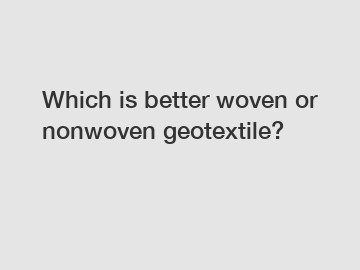Jan. 07, 2024
Construction & Real Estate
If you want to learn more, please visit our website EcoGeoX.
When it comes to geotextiles, the choice between woven and nonwoven materials has been the subject of much debate among engineers, geotechnical experts, and environmental professionals. Both options have their merits, and the decision ultimately depends on the specific requirements of the project at hand. Today, we delve into the differences, benefits, and applications of woven and nonwoven geotextiles, providing you with valuable insights to help you make an informed choice.
Woven Geotextiles: Strength in Structure.

Woven geotextiles are made by weaving polymer strands together, resulting in a durable, fabric-like material. Their inherent strength and structure make them ideal for various applications, especially those requiring load distribution and stabilization. This makes them highly suitable for road construction, rail embankments, and other high-stress situations where reinforcement is key.
The weaving process allows for a higher tensile strength, making woven geotextiles highly resilient against tears and punctures. They possess excellent resistance to soil movement and can effectively distribute loads, reducing the potential for soil erosion and settlement. Their rigid composition also makes them suitable for filtration applications, preventing soil particles from migrating while still allowing water to pass through.
Nonwoven Geotextiles: Versatile and Permeable.
Unlike woven geotextiles, nonwoven geotextiles are manufactured using a needle-punching or heat-bonding process. This results in a fabric-like matrix with randomly oriented fibers, providing opportunities for applications that necessitate filtration, separation, and drainage.
Nonwoven materials boast excellent filtration properties, allowing water to pass through while effectively retaining fine soil particles. This makes them highly valuable in erosion control, drainage systems, and pavement overlays, where preventing the contamination of underlying soils is essential.
Besides filtration and separation, nonwoven geotextiles are also versatile in reinforcement applications. While they may not have the same tensile strength as their woven counterparts, careful consideration of the project's requirements can still render nonwoven geotextiles a viable choice. Their high porosity, coupled with excellent permeability, ensures efficient water flow, reducing hydrostatic pressure buildup and potential damage to structures.
The Right Geotextile for Your Project.
Now that we've examined the unique strengths of both woven and nonwoven geotextiles, it's vital to understand which situations call for which material.
For projects where soil stability and reinforcement are crucial, such as roadways, railways, and embankments, woven geotextiles shine. Their robust structure and high tensile strength make them the go-to choice, capable of withstanding heavy loads and resisting soil movements.
On the other hand, nonwoven geotextiles are a great fit for applications requiring filtration, separation, and drainage. If your project involves erosion control, subsoil drainage systems, or protecting impermeable liners, nonwovens offer superb permeability and filtration characteristics while ensuring structural integrity.
Conclusion:
Choosing between woven and nonwoven geotextiles is not a one-size-fits-all decision. Both variants have clear strengths and specific applications. By understanding the distinctive properties of woven and nonwoven geotextiles, one can identify the most suitable material for a given project, ensuring successful outcomes and long-term durability. Remember, expert advice and careful analysis of project requirements are crucial when making your final decision.
If you are looking for more details, kindly visit our website.
Are you interested in learning more about concrete protective lining custom? Contact us today to secure an expert consultation!
If you are interested in sending in a Guest Blogger Submission,welcome to write for us!
All Comments ( 0 )